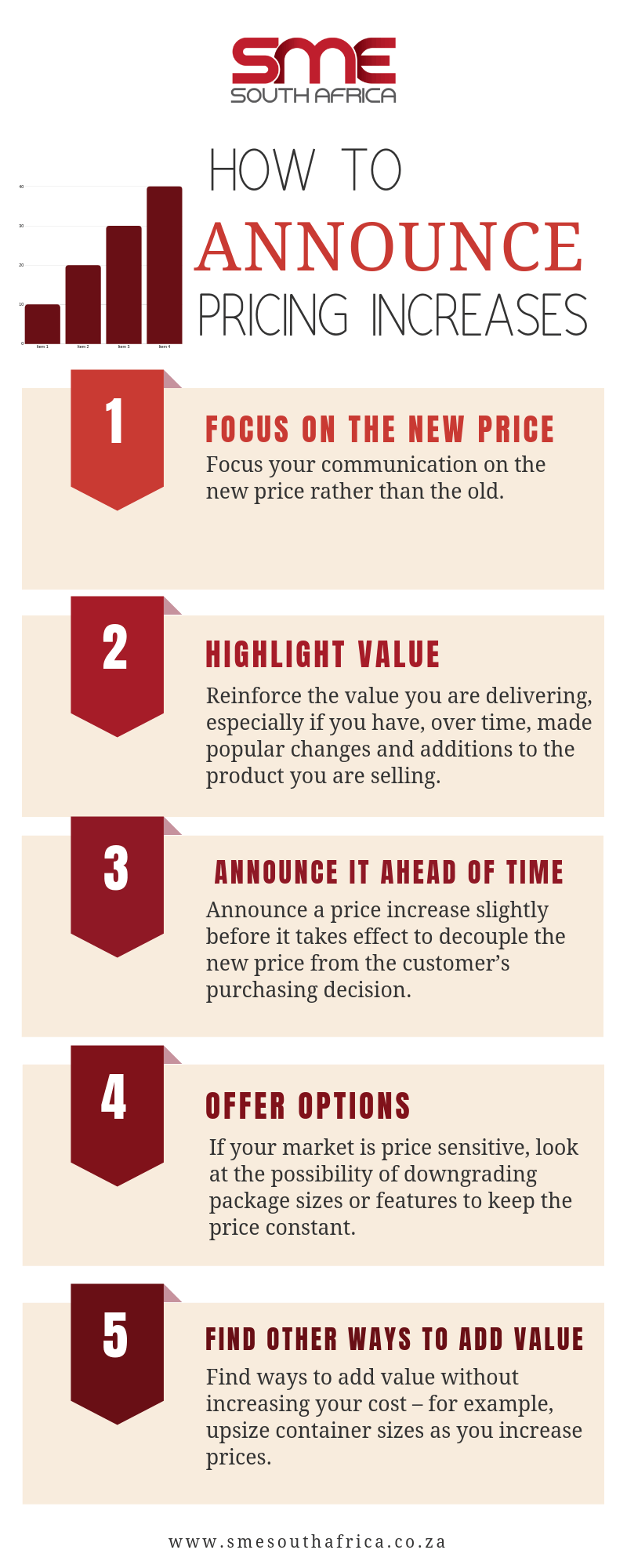
Are you struggling with how to price your product or service? SME South Africa has compiled a guide with factors to consider when pricing your goods or services.
‘If you can defend your value, you can defend your price’
The most important thing for South African manufacturers to consider when setting their prices is value for money. “If you can defend your value, you can defend your price,” says Deryn Graham, Public Relations Manager of Proudly South African, an organisation which seeks to increase local production and influence consumers to buy local.
Graham warns that there is a notion that South African goods are more expensive than imported ones.
“[This notion] needs debunking, as well as issues around value versus price. I would just start by saying that Proudly SA does not have any products of its own, rather we are a membership-based organisation and our member companies set their own pricing.
“There is a prevailing mindset in South Africa that what we make isn’t as good as imported items, that our products don’t have the same cachet as so-called exotic imports. However, as soon as something is endorsed by an overseas celebrity, all of a sudden we recognise the designer or manufacturer and are prepared to go for it. For example when Beyonce or Oprah wears a South African designed outfit, the SA designer’s popularity soars.”
Graham gives an example of fashion brands that stick to their guns despite receiving backlash for being ‘too expensive’.
“Tshepo the Jean Maker who just made news because he gave Meghan Markle a pair of his jeans was slammed when he launched for the price point of his jeans (around R900 at the time). However, South Africans pay up to R10,000 for True Religion, Sissy Boy, Replay and other imported brands of jeans. Why?”
Graham adds: “Laduma by Maxhosa is another ‘expensive’ designer. But he has stuck to his price point and recently exhibited at New York Fashion Week.”
Here is a comprehensive list of factors to consider when putting together your pricing strategy:
1. Factor in the production costs
“We work with a group of women in Diepsloot to create unique up-cycled products. We firstly look at the materials required to make these products and then, more importantly, the labour fee and time involved for each product.” – Christi Jackson – Director of operations and co-founder of The Re-Generation
Pricing formulas for small business owners
2. Consider the cost of logistics
“Delivery charges and security are the biggest purchasing factors in our industry. The fashion and e-commerce industry is one that is high paced, the turnover of products need to be quick as customers want new products frequently, so the price has to be just right [in order for] items to sell fast, but also to cover our overheads (logistics, storage, staff, photography, marketing, security, software, web maintenance).” – Roxanne Page, Managing director and co-founder of SassyChic
Advice for hitting the pricing sweet spot
3. Put yourself in your customer’s shoes
“Sometimes when it comes down to the wire, I will ask myself (a woman and online fashion consumer) – ‘if I was buying this product at another retailer what would I be prepared to purchase it for? What do I personally think it’s worth and is it fairly priced?'” – Roxanne Page, Managing director and co-founder of SassyChic
Entrepreneurs share their pricing lessons
4. Consider price bundling
“Depending on what you’re selling, putting together bundles can be a great pricing strategy. An obvious example is a fast food shop that offers a burger meal, including:
- A high value burger that is the most expensive part of the offering to produce;
- An item such as fries or salad which the consumer sees as a nice-to-have rather than the main attraction, and which is cheaper for the restaurant to purchase;
- A low-value extra to round off the package – a coffee or a machine soda.” – Viresh Harduth | Vice President: New Customer Acquisition (Start up and Small Business) at Sage Africa & Middle East
More pro tips for pricing your products
5. Know how to communicate price increases
“Reinforce the value you are delivering, especially if you have, over time, made popular changes and additions to the product you are selling.” – Viresh Harduth, Vice President: New Customer Acquisition (Start up and Small Business) at Sage Africa & Middle East
More best practice approaches to communicating a new price

6. Be wary of opening specials
“One of the most common reasons to offer discounts is to get customers to try out your goods and services, in the hope that they’ll become repeat customers. Another common tactic is to offer a discount on a popular item to entice customers into your shop, with the expectation they’ll buy other products at their normal prices. Yet many bargain hunters are only interested in chasing the lowest prices – they might not come back to fill their baskets with the goods you’re selling at full price…” – Viresh Harduth, vice president of new customer acquisition (Startup and Small Business) at Sage Africa and Middle East
7. Experiment with different price points
“Try doing this – experiment during a less-busy period: Adjust your pricing and see how customers react. Customer feedback is also important and will provide you with information on what you are doing right and what should possibly change.” – Viresh Harduth, Vice President: New Customer Acquisition (Start up and Small Business) at Sage Africa & Middle East
8. Do not devalue your brand
“If you’re in a premium market – for example, selling handmade furniture or artisanal food – a discount may harm your brand. Customers may think that your beds or bread are not bespoke, quality products if they do not retain their premium pricing.” – Viresh Harduth, Vice President: New Customer Acquisition (Start up and Small Business) at Sage Africa & Middle East
9. Consider subscription models
“From video streaming services to online accounting solutions and gym membership, offering customers access to a service or product on a monthly subscription is a proven business model. Think about whether there is any element of your business that lends itself to a subscription, preferably a scenario where customers using more of it will not add to your costs.” – Viresh Harduth, Vice President: New Customer Acquisition (Start up and Small Business) at Sage Africa & Middle East
More innovative pricing strategies
10. Do your research
“We try to mimic industry leaders and somehow make our prices a little bit less than what they charge. Sometimes we use percentage margin of whatever we are selling. For example, with QBER (one of our mobile apps) we take 15% off whatever our partners are charging.” – Pule Phafane – Founder and director of TechCloud






